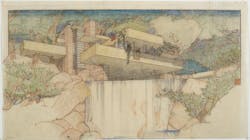In Celebration of Frank Lloyd Wright's 150th Birthday
There’s no denying the impact that Frank Lloyd Wright (June 8, 1867-April 9, 1959) had on American architecture. Considered by many to be the premier architect of the turn of the century, Wright’s name and work are recognized by both design professionals and lay-people, with, of course, his most notable works being Solomon R. Guggenheim Museum (1959) in New York City and Fallingwater (1935) in Mill Run, PA. This year marks his 150th birthday.
Born on June 8, 1867 in Richland Center, Wisconsin, Wright first found employment as a draftsman for the architectural firm of Joseph Lyman Silsbee in Chicago. His vision for modern American architecture eschewed from the contemporaneous Beaux-Arts style which heavily influenced design until 1920, instead he built his reputation on what would become known as “Prairie style,” completing approximately 50 projects by 1901.
Although he had great regard for William Morris and John Ruskin, he believed greatly that the technology of the time had the ability to transform our built spaces in a dynamic way. Stating in his March 20, 1901 address “The Art and Craft of the Maching to the Chicago Arts and Crafts Society, “ The great ethics of the Machine are as yet, in the main, beyond the lens of the artist or student of sociology; but the artist mind may now approach the nature of this thing from experience, to prove, that machine is capable of carrying to fruition highest ideals in art—higher than the world has yet seen!” To Wright, technology—that is to say, the machine, which was the new technology of the era—was capable of perfecting the ideals of art and design, creating a more perfect image of what the architect was attempting to create.
This isn’t to say, however, that he put into effect the futuristic ideals that we commonly associate with technology. Instead, he used what he knew to better blend his work into the environment, seeing it human nature to be one with the earth around them. To quote, “The good building is not one that hurts the landscape, but one which makes the landscape more beautiful than it was before the building was built.”
In this image, we see one of his most important works, Fallingwater. Also known as the Kaufmann Residence for the family for whom it was built in 1935, Fallingwater integrates the built environment into the natural landscape. What’s more, Wright believed in the genuine use of material—which is to say, he utilized materials in a way in which their natural features were not masked. Unlike the Beaux-Art style, which used materials which mimicked others and covered them with ornamentation, Wright’s style pared down the materials to their elements, allowing them to take center stage.
He was honored by the American Institute in 1991 as “the greatest American architect of all time,” and is remembered as a colorful personality which was able to take center-stage in all he did.
This year, in honor of his 150th birthday, the Frank Lloyd Wright Trust is celebrating with events in Chicago, Washington, D.C., and New York City, as well as online.
Additionally, the podcast 99 Percent Invisible has a well-done dual-episode on Wright’s work on Usonia—the idealistic response to midcentury tract housing—titled “Usonia 1,” and “Usonia the Beautiful.”
